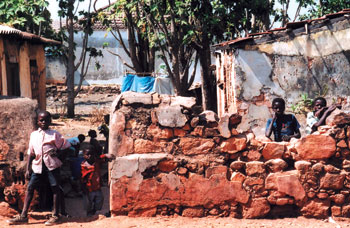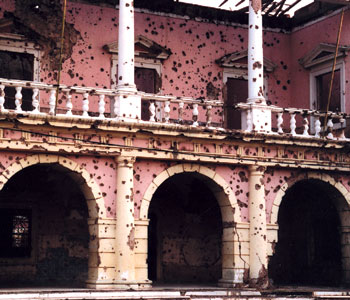
A Street in Toamasina Province, Madagascar
|
| REPORT ON AFRICA |
|
Leprosy Elimination Progress in the WHO Africa Region
By Dr. Bidé Landry, Regional Adviser, Leprosy Elimination Programme, AFRO (WHO - Regional Office for Africa) |
| Trends and the Current Situation |
| In the WHO Africa Region (composed of 46 countries with more than 700 million inhabitants),
substantial progress has been made toward eliminating leprosy since the 1990s. All member states have realized
that elimination is tied in with poverty alleviation and in each country a high political commitment is evident in
the high priority placed on the elimination of this stigmatizing disease. |
| In 1994, when the ministers of health adopted resolution AFR/RC44/R5 to eliminate leprosy as a
public health problem on a regional level, 42 countries were highly endemic. More than two-thirds of them had
prevalence rates of more than two cases per 10,000 inhabitants. |
| Today, only nine countries have a prevalence rate of more than one in 10,000 and only three have worryingly
high rates. All other countries have made dramatic reductions. |
| With the intensification of leprosy elimination activities, more countries are beginning to reveal their
true conditions. Tanzania is one of these countries. The leprosy programs in the Republic of the Congo, Sierra
Leone and Liberia have been disrupted by war and social conflicts, leading to fluctuating prevalence rates. The
magnitude of leprosy prevalence in DR Congo and the Central African Republic is still not fully known despite
the low prevalence rates they have been showing for years. |
Prevalence Trends Since 1996― Each country in the region has organized national leprosy elimination
programs with corresponding systems to collect information on leprosy cases. In 1999, the average
prevalence rate for the region was 1/10,000. Seven countries had prevalence rates of more than 2/10,000 and
were classified as priority countries by the Global Alliance for the Elimination of Leprosy.
In 2002, three years after the 1999 global evaluation of the elimination effort, only three countries were still
considered highly endemic and at risk of not reaching the elimination goal. |
| Detection Trends Since 1996―In the early nineties, WHO recommended that all countries
implement special actions to detect and treat the backlog of hidden leprosy cases throughout the region. The
resulting interventions were successful. But an important aspect was often overlooked: the stigma of the disease.
Since 1999, “social mobilization activities” have been developed and encouraged by WHO, aiming toward
better knowledge of the disease and a reduction of its negative cultural and social impact. This initiative has
assisted the implementation of special projects and facilitated case detection activities. |
| |

Children in Camakupa, Bie Province, Angola |
| The Current Regional Situation |
The current regional situation is very encouraging. In spite of many emerging and re-emerging diseases and
various complications, countries have maintained leprosy elimination as a national priority.
The number of countries that have reached the elimination goal has risen from 32 in 2002 to 37.
Nevertheless, most of these 37 countries are looking for further support toward strengthening leprosy elimination
efforts ― a post-elimination program based on integration, early case detection, treatment and
integrated surveillance of the disease. |
| Conditions in the Most Endemic Countries |
| Angola is one of the most leprosy endemic countries in the WHO Africa Region, with a prevalence rate of
3.64 cases per 10,000 inhabitants and many highly endemic and difficult to access provinces. The general
populations in these areas have little awareness of leprosy, which contributes to maintaining the stigma attached to
the disease. |
| Several factors would help in achieving the goal of elimination, including the end of civil strife, greater government
involvement in reconstruction and development efforts ― including improved technical training of human
resources in the health sector and greater financial input toward control and elimination of diseases. |
| The most remarkable achievement in Angola is the geographic coverage of the program. In 1999, this
coverage was less than 25 percent due to war and the absence of political commitment. Within two years, the
program has accomplished a great deal, training all health staff at provincial and municipal levels, and
organizing leprosy case-management activities at all public and private health facilities. |
| The first concrete result of this achievement has been an increase in detection, from 1,840 in 1999, to 4,272
new cases in 2002, resulting in a detection rate of 29.63/100,000. |
Madagascar has some of the most difficult to access areas in the WHO Africa Region. Some 60 percent of
the country remains relatively isolated due to mountains, an absence of roads and the rainy season.
The health system is built around 2,500 peripheral health centers, which are divided among 111 health
districts. |
| The program was largely suspended for four years due to difficulties in collaborating with the Ministry of
Health. Despite the presence of NGOs during this period, little progress has been achieved. |
| With the resumption of collaboration with WHO, an appropriate plan for the elimination of leprosy has
been established. Priority is given to human resources and clarification of the leprosy situation in the country.
Much has been done in the past year in terms of the clearing of leprosy registers, training of health workers
and reorganization of case management activities and reports. |
| Mozambique is the third most endemic country in the WHO Africa Region. At the end of 2002, the
prevalence rate was 3.63/10,000. |
| In the provinces, MDT (Multi-Drug Therapy) coverage is low, primarily due to the lack of general
health system coverage. |
| Mozambique will likely achieve elimination in time if higher priority is given to case management activities.
The high level of political commitment the program benefited from last year must be maintained. |
| Mozambique registered a relapse-rate of 63 percent last year. This situation needs more assessment. The
experience of village health workers who deal with leprosy needs to be evaluated and the way forward
defined in order to improve the implementation of leprosy elimination activities in highly-endemic areas. |
| Perspective―The elimination of leprosy at a national level in all countries throughout the WHO
African Region is achievable by the year 2005. The recent visits to Angola and Madagascar jointly organized
by the WHO Regional Director, Yohei Sasakawa, and the president of the Association Francaise Raoul
Follereau have been very helpful in strengthening the political commitment to the elimination effort.
Better coordination among partners to boost isolated efforts will speed the achievement of the elimination of leprosy. |
| |

Many public buildings lay in ruins in the aftermath of Angola’s civil war.(Kuito City, Bie Province) |
|